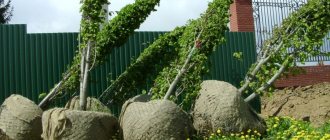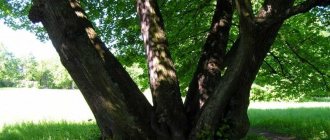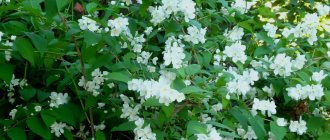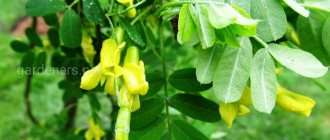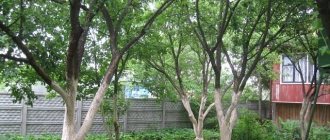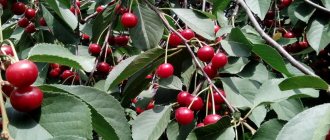Both in classical and modern gardening, the cultivation of berry bushes was considered not only from the standpoint of providing estate owners with a harvest of various fruits, but also as an elegant element of landscape design. However, in many suburban areas one can sometimes observe the lack of a systematic approach to arranging this part of the garden. Land owners usually prefer to pay more attention to planting an orchard, losing sight of the fact that fruiting of berry bushes occurs before fruiting of fruit plantings. In addition, berry bushes are less demanding on the soil, adapt more easily to the climatic conditions of the area and do not require large areas of land.
For abundant fruiting, plants require compliance with two basic conditions: moderate heat and sufficient soil moisture. Gardeners of the 19th century noticed that the best development of young raspberry, currant and gooseberry bushes in central Russia occurs when the soil is heated to 18-25°C, but at higher temperatures the root system begins to suffer from excess heat and lack of moisture. It is for this reason that it is important to take into account the characteristics of the climatic zone: in the southern regions, it is advisable to plant bushes in rows at the same level with the soil surface of the entire site; in areas with colder climates, high ridges are built.
Preparing for landing
To plant berry bushes, prepare ditches about a meter wide and about 60-70 cm deep. On poor soils, it is undesirable to plant in separately dug holes, because After 2-3 years, the roots will go beyond these holes and will be deprived of the nutrients necessary for their growth and development. The method of planting berry bushes in holes is justified only in the presence of loamy or chernozem soils.
To make the site look aesthetically pleasing, lines along which the planting will be carried out are first outlined. Moreover, they do this in such a way that there is a distance of about 150-180 cm between the rows - in the northern lane; and about 180-200 cm – in the middle and south. Taking these lines as the center of future planting ditches, measure 45-50 cm in both directions. You should dig in such a way that the upper part of the ditch is wide, and as it deepens it noticeably narrows. This is due to the fact that in most berry bushes, as they grow, the root system is distributed along the top of the planting ditch.
The ditches are prepared in advance: if autumn planting is planned, the ditches are prepared in the spring; for spring planting - in autumn. The lower layers of soil in the planting ditch should be enriched with nutrients: experienced gardeners use bone meal and ash for this purpose. Fertilizer is poured into the bottom of the hole, filling it to about a quarter of the depth. The upper part of the ditch is covered with earth mixed with well-rotted cow dung. Instead of ordinary soil, you can use a mixture of one part turf soil, one part deciduous soil and one part well-rotted mullein.
Planting honeysuckle
The distance between plants is 1.5-2 m. The root collar should be at ground level, when planted 3-5 cm higher. Soil mixture: turf soil, humus or peat and sand in a ratio of 3:1:1. Optimal soil acidity pH 7.0-8.5. Drainage: A layer of broken brick or gravel 5-7 cm. In early spring, feed the plants with mineral fertilizer at the rate of 20-30 g/sq.m. m, before flowering, 3 liquid fertilizers are applied: 10-20 g of nitroammophoska per 10 liters of water.
Foliar feeding: 0.1% urea, 1% superphosphate, 0.5% potassium chloride. Summer sprinkling alternates with foliar feeding. In the fall, wood ash (100-200 g/sq.m.) is added for digging. The recommended rate of fertilizer application per planting hole for honeysuckle is 5-7 kg of manure, 50-80 g of superphosphate and 40-50 g of potassium salt.
Water 7-8 times a season, 1.5-2 buckets of water per plant. In the first year they water more and more often, then watering is reduced to a bucket. In hot weather, young plants are watered more often and more abundantly. Loosening is carried out 4-5 times a season when weeding or in case of soil compaction. Loosen with a shovel, since the depth of the roots is 40-50 cm, the trunk circle is large 1-1.5 m. Mulch with peat. layer 5-7 cm.
Gooseberry
Almost all varieties of gooseberries provide good fruiting when located in areas exposed to the sun: shrubs planted in the shade often freeze because their shoots do not have time to fully ripen before the onset of frost, which is only possible in a sunny location. In regions with hot climates, this shrub can also be planted in slightly shaded areas.
Gooseberries are undemanding in terms of soil composition and grow well on both sandy and clay soils, especially if they are deeply dug, thoroughly fertilized, regularly loosened and not overgrown with weeds. On sandy soil, the berries ripen earlier and are sweeter, although they do not reach the same size as on more fertile soil.
As a rule, gooseberries are planted either in a specially designated area or between fruit trees. But in the latter case, the bush will have to be replanted when the overgrown tree crowns begin to shade it. At one time, in landscape design, gooseberries were used for planting ridges near paths: the bushes were planted at a distance of 80-150 cm from each other and pruned in time so that the branches retained the desired shape and did not grow too much.
Planting plum and cherry plum
Plum is light-loving. The distance between plants is 4-5 m, for low-growing varieties 2.5-3 m. Keep in mind that plum is a more heat-loving crop compared to cherries. Plum prefers fresh fertile or clay soils and does not tolerate stagnant waterlogging. Soil mixture: leaf soil, humus, sand (3:2:1) with the addition of lime or dolomite flour (200-300 g) per planting hole.
Watering is required when planting and in the next 3-4 days. Tolerates short drought relatively well. Young plants require more frequent watering during dry periods. Loosening is carried out to a depth of 5 cm in order to destroy weeds. In early spring and late spring - early summer, fertilize with nitrogen-containing fertilizers; in autumn - potassium-phosphorus. Mulching the tree trunk circle with peat, peat compost, wood chips. The thickness of the mulch layer is 8-10 cm.
Planting gooseberries
The best time for planting is determined by the climatic characteristics of the region: for example, in the northern zone it is better to plant berries in the spring. If the shrubs were purchased in the fall, then for the winter they are simply buried in a dry place protected from the winds, and planted in a permanent place in the spring. In the southern zone, where frosts begin quite late, gooseberries can be planted in September - the bush has time to take root well, so with the onset of heat it quickly grows without wasting resources on rooting.
Surface fertilizer is of great importance when growing gooseberries: a layer of humus or well-rotted mullein is poured into the holes formed around the bushes after slight subsidence of the soil. The best results are shown by applying fertilizer in early spring, after the first loosening of the soil. Thinning the bushes also contributes to obtaining a bountiful harvest: when pruning, branches older than 4 years of age and young branches that grow too closely or have an inclination into the bush are usually removed. The center of the bush is cut so that strong side branches receive enough sunlight and air.
When using gooseberries as an element of landscape design, they are often given the shape of a tree. To do this, leave one strong, even shoot of the bush, removing all the others as they appear. After the shoot reaches a length of about 50 cm, pinch off its top, and from the side shoots only 3-4 pieces are left, the most even and strong. It is these side shoots that will subsequently form the beautiful crown of the “tree”. Next year, 2-3 most advantageously located side shoots are again selected on the “branches” of the future tree, and the root shoots and other shoots are cut off - thus setting the desired crown shape.
Planting blueberries
The soil when planting blueberries should have a pH of 4.0 to 5.2. It is recommended not to use organic fertilizer; you can only use peat or softwood sawdust. The soil should have good drainage. Groundwater should not exceed 50-60 cm depth to the surface of the earth. Otherwise, it is necessary to make a fill furrow for planting.
On a personal plot, you need to dig a hole with a diameter of 40 cm and fill it with a substrate that contains acidic peat and soil in a 1:1 ratio. The seedlings are planted 5-10 cm deeper than they grew before. If planting occurs in the fall, then fertilizing is not done. In spring, fertilize with mineral fertilizers that acidify the soil. After fertilizing, be sure to shed it with water. You can use different mineral fertilizers, but under no circumstances overfertilize with nitrogen.
In autumn, it is recommended to add ground fill (mulch) with sawdust, bark or peat. During flowering, flowers tolerate a temperature of -2°C; if the temperature is lower, then they must be protected by spraying or otherwise. For planting, choose sunny, windless places. During fruiting, each bush requires 8 liters of water per day. To achieve large berries, it is recommended to trim the branches, leaving a bush with 5-7 branches. Berries are formed on the branches of the previous year.
Propagation of gooseberries by seeds
As a rule, most gardeners prefer to propagate gooseberries by cuttings and layering, although in some cases they also use seed sowing. To obtain high-quality seed, it is necessary to select the best berries, leaving them on the branches until they become completely soft. Such berries are carefully cut with scissors and left to lie on the windowsill for another ten days. Then the shell is cut, the seeds are separated from the pulp, thoroughly washing them with water. Dried seeds are stored in a paper envelope until sowing. The best time for sowing is autumn, but if there is a need to postpone sowing until spring, then the seeds are stored in slightly damp sand.
Despite the fact that gooseberry grains are quite small, they need to be sown, leaving large gaps between the holes, because sprouted plants must be left in the ground without replanting until autumn. At the end of August - beginning of September, temporary beds are prepared for young bushes, leaving a distance between rows of about 50-70 cm, and between plants - about 25-30 cm. When the young bushes produce the first berries (usually this happens in 3-4 years), the strongest and healthiest plants are planted in a permanent place in the garden, and all the rest are left in a temporary bed for another year.
Planting a pear
The distance between plants in groups is 3-4 m. The root collar is 3-4 cm above the soil level. When planting under one tree, add 60 kg of rotted manure or humus, 1.5 kg of superphosphate, 0.7 kg of potassium chloride and 3 kg of lime. Prefers slightly acidic soils or neutral (pH 6-6.5), well-aerated soils.
Fertilizers are applied once every 2-3 years in the spring at the rate of 4-5 kg of peat or manure per 1 sq. m. Phosphorus-potassium fertilizers are applied in the fall. In dry weather, water after 20 days. They loosen the pears to a depth of 10 cm. Mulch with rotted manure, peat, compost with a layer of 6-8 cm. In the spring, 2-3 weeks before the start of the growing season, cut out broken, dry and diseased branches, thin out the crown. As they appear, the tops are cut out.
Gooseberry propagation by layering
For this method of reproduction, the strongest specimens are selected. The ground around the bush is carefully loosened, then individual shoots are attracted to it with hooks. The place where the shoot is attached is carefully covered with soil, which is kept moist. Sometimes, to speed up this process, the removed shoot in the place where it will be covered with earth is slightly damaged: it is slightly incised, slightly twisted, i.e. promote increased movement of juice and the formation of young roots.
If it is necessary to obtain not one, but several young individuals, then layering is done in a slightly different way: thin branches are pressed to the loosened soil along their entire length and lightly, literally 5-6 cm, sprinkled with loose soil. Shoots will have to develop from all the eyes present on the branch. At the end of summer, the branch can be cut into separate fragments (young individuals) and planted in temporary beds.
When to plant fruit tree seedlings in spring
Timely planting of fruit tree seedlings in the spring is important not only for their survival, but also for the subsequent growth and development of plants. The question arises when is the best time to plant fruit trees and shrubs in the spring.
Since changes in nature occur very quickly, the air temperature rises, the soil dries out quickly, so the best time for the procedure is considered to be early spring, although in the southern regions it can be done in the fall. However, a crop such as cherry often freezes when planted in the fall, so it needs to be planted only in the spring. Moreover, the sooner the tree is planted, the better and faster it will take root.
How to choose a landing site
When choosing a place to place fruit crops, you should pay attention to several factors: the depth of groundwater, lighting and the presence of drafts. Thus, groundwater must lie at a depth of at least 1 m. Otherwise, trees will have to be placed on mounds 60-120 cm high.
It is known that fruit trees need a lot of sunlight and warmth, so it would be wise to choose a site that is well lit by the sun, preferably on the south side of the site. In addition, it should be taken into account that young trees are afraid of drafts, so you should try to place the young garden under the protection of buildings. Experienced gardeners recommend not planting seedlings in the same place where fruit trees used to grow. The wasteland area remaining after uprooting the garden must be sown with meadow or legume grasses for several years or the soil in the pits must be completely changed.
Planting fruit tree seedlings in spring timing
Spring planting should be carried out as early as possible, the determination of which depends specifically on the seedling and weather conditions.
In any case, the work should be completed before the buds bloom on the trees (seedlings). The survival and development of culture in the future depends on this.
Planting fruit trees in spring: video
When to plant fruit tree seedlings in the spring and how to do it correctly, you can see in the video clip. Its author will give valuable practical recommendations for planting, which will certainly be useful to beginners and experienced gardeners.
Propagation of gooseberries by cuttings
Unlike currants, propagation of gooseberries by cuttings is much more difficult. Cuttings planted in open ground produce such a small percentage of rooted plants that greenhouse propagation is more effective.
Cuttings are cut from the current year's shoots at the time when they have finished growing and are sufficiently strong. As a rule, such shoots are quite flexible and do not break when you try to bend them. Each cutting should be quite long: approximately 7-8 eyes; All leaves must be removed from the lower part, which will be immersed in sand.
Sand or soil-sandy soil is poured into the greenhouses, the beds are tightly covered with glass or film, which are shaded so that the plants are not exposed to direct sunlight. As soon as the cuttings take root, they are planted in temporary beds, but in areas with a fairly cold climate it is recommended to leave the young plants to overwinter in greenhouses.
How to properly plant seedlings in the fall
If it is already clear that the gardener was late with all the deadlines for autumn planting, but the seedlings have been received, it is better to dig them in.
The seedlings are buried under a strong slope, so two-thirds of the trunk is covered with soil, and the rest is covered with snow, and the seedling is stored until spring, like in a refrigerator. It is necessary to dig in a place where there will definitely not be a puddle in the spring after the snow melts; it is also important that the digging site and the future planting site thaw at the same time, that is, definitely not in the shade of a building or fence. In the fall, you need to spread mouse poison, water it well and cover it with spruce branches, and in winter trample the snow.
Andrey Vasiliev
In order to create a refrigerator that works as long as possible, in winter I sprinkle snow into the pile, sprinkling the snowdrift with sawdust in layers and shading it with spunbond.
Currant
Caring for all varieties of this berry bush is not much different from caring for gooseberries, but currants reproduce equally well by seeds, layering, and grafting. Traditionally, propagation by cuttings is considered the easiest way, because they take root quite easily and quickly take root at a temporary or permanent planting site.
The most successful time for planting cuttings is considered to be early spring or early August. The length of the cuttings to be cut directly depends on the variety of currant: the stronger the growth of the bush, the longer the cuttings should be. For propagation by this method, last year's young shoots or, in case of their deficiency, two-year-old branches are usually used. The lower cut of the cutting is usually made in a straight line, immediately below the first bud; the upper one is above the kidney, obliquely. There should be 6-8 eyes between the top and bottom cuts.
Experienced gardeners also practice propagation by “arc” cuttings. To do this, cut off long young shoots and plant them in beds, having previously bent them into an arc so that the upper and lower ends of the cuttings are immersed in the ground. As practice shows, the rooting of such cuttings occurs somewhat faster than when using traditional methods.
Planting shrubs
Planting of shrubs can be done both in spring and autumn. All work begins in the spring after the snow has melted and the soil has thawed, and in the fall - before the onset of frost.
Rules
Planting shrubs, just like planting trees, is carried out according to certain rules (Figure 7). First of all, they start with preparing the soil and planting material, and also determine the compatibility of the soil and the selected plants. If the soil does not meet the requirements of a particular shrub, it is necessary to carry out a set of agrotechnical measures to improve the soil.
Shrubs are planted in specially prepared holes, the depth of which must correspond to the height of the plant’s root system. In this case, you should pay attention to the level of groundwater. If they come too close to the soil surface, the planting hole should be 15-20 cm deeper than the standard one to allow for drainage. A layer of soil is poured at the bottom of the hole, then a bush is planted.
Note: It is necessary to ensure that during planting the roots of the plant are straightened and covered with soil. It is recommended to fill the hole with the seedling 5-10 cm above the general soil level, however, the root collar should not be buried in the ground.
The planted plant must be watered, possibly with the addition of growth stimulants. Further care consists of feeding, watering and trimming the branches.
Peculiarities
Planting of shrubs in the fall is carried out taking into account the characteristics of certain species. Thus, there is no need to prepare special holes for raspberries, since their annual seedlings are planted in fertilized soil under a shovel. But for currants and gooseberries, shallow holes are needed. These plants are best planted when they are two years old.
Before moving into the ground, branches of shrubs must be cut so that their length from the roots is from 25 to 30 cm. This procedure will help reduce evaporation, and in currants and gooseberries it will stimulate branching of the bush. Before planting, it is recommended to dip the root system of the bushes in soil or clay mash to protect it from drying out.
Figure 7. Features of planting shrubs
The rows of bushes are marked with a rope, placing them parallel to the rows of trees between the rows. If the planting of shrubs is located separately, then the distance between the rows and in them is one and a half meters. The exception is raspberries, which can be planted at intervals of 70-80 cm. The soil around the planted plants must be compacted and watered at the rate of 1 bucket of water per 4-5 seedlings. After absorbing moisture, you can mulch the planting circle with peat or humus.
Note: It is important to know that raspberry bushes should not be planted deeper than in the mother area. But currant and gooseberry seedlings, on the contrary, need to be planted deeper than before. This way they can develop additional roots and grow better.
As for strawberries and strawberries, these plants are planted in a slightly different way, since they are herbaceous. So, it is best to plant strawberries from the end of July to the beginning of September, because late planting will not allow the plant to take root well before the arrival of winter. It is practiced to plant strawberries between the rows of fruit trees or in a separate area. In this case, strawberries are planted in rows, maintaining an interval of 20-25 cm between bushes and rows. After every three rows, it is recommended to leave a half-meter wide passage. If there is not enough space, you can plant strawberries in the rows of fruit trees or berry bushes at a distance of one and a half meters from them. With this planting, the plants are arranged in a row with an interval of 25-30 cm. It is important to ensure that the apical bud of the strawberry is not covered with soil. Watering rate is 1 bucket for 15-20 plants. To ensure that moisture is retained longer and the surface layer of soil is not covered with crust, it is recommended to mulch the plantings with fine manure or peat.
Where to plant shrubs on the site
The undeniable advantage of shrubs is the fact that they not only produce tasty and healthy berries, but can also serve as a wonderful hedge. The choice of location on the site for planting shrubs is carried out specifically for each species. For example, currants prefer moist and well-lit places (between two fruit trees, near a fence or the wall of a house). But rosehip does not tolerate too moist and saline soil; it loves light and warmth.
Gooseberries are also afraid of excess moisture, but they tolerate short-term drought well. So, the choice of a permanent place for planting berry bushes should be taken seriously, since the bushes grow quickly, and replanting a large plant is much more difficult.
Planting types
There are several types of planting shrubs:
- Tree and shrub group;
- Alley;
- Hedge.
The tree and shrub group combines several species of plants (both trees and shrubs), located separately on the site. For this type of planting, plants with similar agrotechnical conditions and compatibility with each other in crown shape, flowering time, etc. are selected.
An alley is a group of tall shrubs arranged in a row at equal distances from each other, for example, along a garden path.
If you plant shrubs in one line so that their crowns meet, you can get a hedge that looks much more aesthetically pleasing than any fence.
Trellis forms of currants
In the century before last, the most fashionable elements of Russian landscape design were standard and trellis forms of currants, and the latter were the most popular among owners of suburban areas. To breed trellis forms in the fall of the second year, cuttings of plants were pruned, leaving only two shoots intact, from which palmette or fan-shaped trellis branches were formed.
The decoupling of the shoots along the trellis must be done while they are still quite plastic and easy to mold. When the shoots grew to a length of 4-5 internodes, they were pulled with a rope to the trellis and bent in accordance with the intended shape of the future shrub - this stopped the growth of the shoots and stimulated the formation of lateral buds.
Decorative horizontal fences made of red and white currants look no less impressive: as a rule, they are used to frame flower beds and green lawns. For these purposes, the cuttings are planted in the right place, and one of the developing shoots is left, which is bent parallel to the ground. The shoot is fixed in the desired shape using wooden templates made in the shape of the letter “L” with an elongated upper crossbar.
After 2-3 weeks, when the shoot takes the indicated shape, the template is removed and the branch is tied to a horizontally stretched thick wire. Such decorative living fences look very beautiful due to the unusually large berries, which effectively combine with the plants blooming in the flower beds. The peculiarity of molded fruit growing, in addition to its magnificent visual component, also lies in the fact that the berries on molded trees are usually much larger than on traditional bushes.
This is due to the fact that the juices are not directed upward, but are retained on the artificial bends of the branches, which has a beneficial effect on the fruiting of the bush. In addition, the branches are located at a sufficient distance from each other, and therefore receive sufficient sunlight, unlike an ordinary bush, where, as a rule, only the outer shoots bear fruit.
Planting fruit and berry trees
Gardens are laid in areas with different topography, groundwater levels and light levels. However, there are certain rules that must be followed when planting a garden, regardless of its location.
It must be remembered that improperly planted trees do not take root and grow well, which can lead to their death.
Rules
Planting of fruit and berry trees is carried out in accordance with certain rules, which not only ensure the survival of plants, but also improve the volume of fruiting in the future.
The basic rules for planting fruit and berry crops include several important points (Figure 5):
- The pits must be prepared two weeks before the planned planting. Moreover, their size depends on the quality of the soil, but should not be less than 50-60 cm in depth and width.
- When digging holes, the soil is laid out in two parts: the upper fertile layer and the lower, less fertile layer, separately. The bottom layer is enriched with nutrients by adding compost to it. The use of manure for this purpose is not recommended, since even in a rotted state it can damage the bare roots of plants.
- The bottom of the hole must be loosened to improve air access to the roots of the plant. If the soil is sandy, then a 15 cm thick layer of clay is placed at the bottom of the hole, which will retain the necessary moisture.
- A few days before planting, the pits are filled with fertilizers (2-4 buckets of humus, phosphorus - 200 g, potassium chloride - 100 g, wood ash - 1 kg per hole measuring 60-100 cm). All fertilizers are mixed with the soil, which is intended for filling the hole. If the hole was dug and filled in the fall, then this work is not carried out in the spring.
- Before placing the seedling, a stake 5-6 cm thick and 1.3-1.5 m high on the leeward side must be driven into the center of the hole.
- Planting material must be carefully inspected, all damaged or diseased branches and roots must be trimmed.
- You can keep the seedling in a container with water for 1-2 days so that its root system accumulates a sufficient amount of moisture for rapid establishment. It is also recommended to dip the root in a mixture of clay and manure (clay, mullein, water in a ratio of 1:2:5), which will ensure good contact of the roots with the soil.
Figure 5. Features of planting fruit and berry trees
Immediately before planting, a mound of soil filled with fertilizer is poured onto the bottom of the hole, then a seedling is placed on it on the north side of the stake and the roots are straightened. The hole is covered with a fertile layer of soil removed when digging the hole, compacting it and regularly shaking the seedling. This is done to ensure that voids do not form between the roots. Ultimately, the root collar of the seedling should be slightly higher than the soil level in the garden in order to be level with it after watering.
After planting, the soil is poured over the diameter of the hole with a small roller, and the circle itself is watered with 5-6 buckets of water. The tree itself must be tied to a stake.
The tree trunk circle should be mulched with organic material to prevent the formation of surface crust and help retain moisture.
Peculiarities
When choosing seedlings, it is useful to know their age, because this significantly affects the survival rate of the trees. For example, apple and pear seedlings should be 2-3 years old, and cherry and plum seedlings should be 2 years old. When deciding on varieties, listen to the advice of experienced gardeners.
Note: Place plants in the garden in rows at a certain distance from each other. So, pears and apple trees are planted at a distance of 6-8 meters, and cherries and plums - at a distance of 3 meters between tall fruit trees and 3-4 meters between rows. You can also occupy the rows with currant or gooseberry bushes. It will be great if the rows of the garden are located from east to west. This way they are better illuminated by the sun in the morning.
To mark out a plot for a garden, you first need to draw a plan of it, where to provide boundaries and the location of rows, paths and flower beds (Figure 6). On the ground, the breakdown is carried out using a rope, tape measure and pegs. The rope is needed to determine and mark the distances that will be observed during planting. It is stretched along the future row, and with the help of knots or scraps of fabric you mark the planting sites. Here you need to ensure that the rows are even. It is not only beautiful, but also easy to clean.
Figure 6. Scheme for placing trees and shrubs
It is recommended to tie the planted trees to stakes to protect them from excessive swaying. To do this, use an ordinary washcloth, which must be secured to a figure-eight support so that the seedling does not damage its tender young bark on the stake.
In addition, after planting the tree, you need to trim its branches. In this case, strong shoots must be shortened by half, and weak ones - a little less. As a result of pruning, the ends of the skeletal branches should end in the same horizontal plane. The central shoot is cut so that it is 20-30 cm higher than all the others. Both lateral and central branches are cut above the outer bud.
Raspberries
Raspberries are rightly considered the most unpretentious berry bush, but this does not mean at all that this plant can be planted in the backyard of the garden, where the sun almost never shines. Raspberries, indeed, prefer light shading, but only in the hottest midday hours; at all other times, this shrub should be open to sunlight. The same applies to soil moisture: excess moisture can be useful for this berry bush only in regions with a fairly hot climate; in the middle or northern zone, increased soil moisture will lead to the fact that varietal raspberries will often freeze out.
It is also worth paying attention to the distance between the rows of shrubs: in amateur gardens, raspberries often turn into impenetrable thorny thickets, which do not allow for good fruiting and a favorable aesthetic perception of this part of the garden. The most rational distance between rows is 80-140 cm (depending on the raspberry variety); the optimal distance between individual bushes is about 1 m.
Which fruits are suitable for autumn planting and which are not?
The most important thing is that the seedling planted in the fall has time to take root. Therefore, the longer the crop takes root, the greater the chance of the seedling not surviving the winter.
Stone fruits take longer to take root than pome crops, so they are recommended to be planted in the spring.
Ideal for autumn planting:
- apple and pear trees (winter-hardy varieties);
- raspberries;
- currant;
- gooseberry;
- honeysuckle;
- chokeberry.
Andrey VasilievConsultant of the “Orchard” section FORUMHOUSE
In the middle zone, we safely plant pome fruits in the fall. Stone fruits will survive with luck and we plant them in the spring. In the south, we plant everything in the fall (or at the very beginning of spring - at the end of the calendar winter) and nothing in the spring, because the heat begins quickly.
For planting fruit crops in the fall, a seedling aged 1-2 years is ideal. These are the ones that winter best. When buying a seedling, you need to check that all the shoots are lignified, mature, and have good buds. There is nothing good about three-year-old seedlings!
The younger the seedling, the shorter and thinner its roots, the easier it will tolerate being dug up from the nursery and planted in a new place.
That is, the smaller the roots, the less they are injured during digging and the better they will take root.
Planting and caring for raspberries
Despite all its unpretentiousness, raspberries are quite demanding on the quality of the soil: a lack of nutrients usually leads to the fact that every year the berry harvest becomes more and more meager - both in quantity and quality. Particular attention should be paid to fertilizing loose and sandy soils: in addition to traditional fertilizing, a sufficient amount of clay should be added to the soil so that the root system does not suffer from excessive dryness.
The time for planting raspberries is determined in accordance with the local climate: in warm regions, autumn planting is advisable; In harsher climates, it is safer to plant raspberries in the spring. The disadvantages of spring planting include the fact that raspberries, as well as currants and gooseberries, when the temperature is favorable, begin to grow too quickly and throw out buds. Bushes planted in this form die during the first dry days. To avoid such an unfortunate circumstance, pre-purchased raspberry seedlings should be kept lightly buried in a dry, high place until spring.
Planting fruit trees
A well-kept orchard is not only a wonderful decoration for your summer cottage, but also a rich source of vitamins.
It will take a lot of effort and time to grow it like this. And our article will also arm you with the necessary knowledge and rules that will help in cultivating an orchard.
Rules
Sometimes it happens that the seedlings were of high quality, and the holes were prepared on time and appropriately, but the garden still does not begin to grow. Most often this occurs because novice gardeners do not know the rules for placing seedlings. It is their strict adherence that guarantees that all your efforts and expenses invested in your future garden will not be in vain.
Planting fruit trees and shrubs is carried out as follows (Figure 1):
- The soil is prepared in advance, for example, for spring planting - in the fall, and includes loosening the soil and applying fertilizers.
- Immediately before transferring to the ground, seedlings must be placed in water for several hours so that the root system has the opportunity to make some supply of moisture.
- Damaged or excessively long roots should be trimmed smoothly.
- The roots of the seedling should be freely placed in the hole.
- It is not enough to simply dig a hole of the required size: you also need to loosen its bottom and lay a layer of compost filled with fertilizer on it.
- It is necessary to drive a support stake into the dug hole on the leeward side.
- The soil that remains from digging a hole is mixed with compost, mineral and organic fertilizers, and sand. This substrate is used to fill the hole after planting a tree.
- The seedlings are placed strictly vertically in the hole. If the tree is grafted, the grafting site should be located above ground level at a height of 10 cm.
- During planting, the hole is filled evenly with prepared soil, compacting it and carrying out intermediate watering.
Figure 1. Rules for planting seedlings
After planting the tree, it is necessary to form a watering circle. To do this, a mound in the form of a roller 5-7 cm high is made along the entire circumference of the hole, and the trunk circle itself is mulched with organic matter (rotted manure, straw, raw compost). The planted tree must be watered abundantly and tied to a peg.
Peculiarities
When planning to plant a garden, you should start by cultivating the soil in the selected area: deeply loosen the soil and remove weeds, because in loose soil, seedlings grow quickly and begin to bear fruit much earlier. Then you need to decide on the size of the holes.
Note: For annual plants, dig holes 50-60 cm deep and wide; for two-year-old plants you will need a hole 110-120 cm wide and 60-70 cm deep. If the soil is heavy, then add 15-20 cm to all dimensions.
If the soil has a high level of acidity, it must be limed. Organic and ash fertilizers are used for fertilizer. It is not recommended to use fresh or half-rotted manure, since if there is a lack of air in the soil, it decomposes and releases harmful substances that poison the entire plant.
Where to plant fruit trees on the site
When choosing a place for fruit crops, pay attention to the topography, the nature of the soil, the depth of groundwater, and the possibility of protection from the wind. At your summer cottage, give preference to a place with good lighting that is not flooded by groundwater. Thus, the maximum height of groundwater for apple and pear trees is 1.5 m, for cherries and plums - 1 m. If groundwater is high, drainage will have to be done (Figure 2).
Figure 2. Placement of fruit trees and shrubs on the site
It is known that gardens grow best on gentle slopes, but flat planting is not so effective. It is not recommended to plant a garden in hollows due to the stagnation of cold air and excess water.
Which side of the world should you plant fruit trees from?
An important role is played not only by the fact of when to plant fruit tree seedlings in spring or autumn, but also by the direction of the world where the garden will be located.
Experienced gardeners advise planting fruit trees on the south, southeast and southwest sides of the site.
Planting types
The correct arrangement of plants in the garden, that is, the type of planting, most directly affects the survival rate of seedlings. Therefore, it is so important to imagine it in all details before starting to lay out a garden. It is also necessary to calculate the distances between seedlings. The interval between them should be no less than the height of mature trees. It is in such conditions that plants will pollinate and bear fruit more efficiently. It is also known that more fruits are produced on the lateral branches, so the crowns of fruit trees should be shaped so that they grow in width (Figure 3).
Figure 3. Main types of planting fruit trees: 1 - in groups, 2 - central placement in bouquets, 3 - checkerboard, 4 - row planting, 5 - row planting of different species, 6 - central planting of shrubs
However, you should know that in too sparse locations, fruit trees are more susceptible to sunburn and frost damage, and therefore grow much worse. In this case, so-called “compactors” are planted between tall fruit crops, that is, low-growing fruit crops, for example, cherries or plums. They are not as durable as apple and pear trees, and therefore stop bearing fruit after 20 years of life and can be removed, since the crowns of tall trees will have already had time to fully form and grow by that time.
Raspberry propagation
Raspberries, starting from the age of two, produce a large amount of root shoots, which are easy to use to expand and renew the berry garden. Instances with weak, bare roots are subject to rejection, and strong individuals with a well-branched root system are cut off from the mother plant with a shovel or a sharp knife and used for propagation.
The most successful time for planting young plants is considered to be autumn: the shoots will have time to take root well and adapt to new living conditions. If for some reason planting is postponed until spring, then the plants buried for the winter should be planted as early as possible, until the shoot that has developed from an underground bud reaches an impressive size.
Compatibility of fruit trees and shrubs when planting
Experienced gardeners have long noticed that some fruit trees and shrubs feel uncomfortable next to other plants or, on the contrary, successfully coexist with them. In the first case, the roots of the plants may be at the same depth and interfere with each other. A situation occurs when one of the plants releases substances into the soil that inhibit the development of others. Therefore, when planning to plant fruit and berry plants, do not be too lazy to look at the table of their compatibility (Figure 8).
For example, apple trees can get along with almost any garden crop, except rowan. Red and black currants do not tolerate proximity to each other and to raspberries, since their root system inhibits the neighboring plant. For this reason, it is recommended to plant raspberries in a separate area. Gooseberries cannot coexist with black currants, and they are not friendly with raspberries.
You will find more information about the compatibility of fruit and berry crops in the video.
How to plant a plum tree in spring
Plum also loves warm places protected from cold winds. It prefers sunny areas, but if necessary it can grow well in partial shade. As with most fruit trees, it is poorly affected by both the close occurrence of groundwater (above 1.5-2 m) and constant drought.
Plum soil needs to be loose and fertile, closer in gravity to the average type, and always neutral acidity. If the soil is acidic, it must be limed in advance (for example, with dolomite flour or ash - about 500 g).
The size of the planting pit for plum is 70x80 cm, drainage is required, the composition of the fertilizer for spring planting is 2-3 kg of compost, 200-250 g of superphosphate, 60-70 g of potassium sulfate.
- 13 important questions about planting and growing plums
Spring is just around the corner, which means new plantings. How to properly plant and care for a plum tree in order to reap the first harvest in a few years?
Technology of securing seedlings
Mature trees, with a huge expanded root system, are supported by roots that cover most of the soil space. Young seedlings do not have sufficient support and therefore need to be additionally secured after planting. Shrubs have a relatively small root system and hold themselves well on the surface of the ground; no supports are installed for shrub plants. There are a number of nuances that should be taken into account when planting.
- Saplings planted with bare roots are supported by one support driven into the hole before planting.
- With a closed root system, pyramidal supports are made from three stakes.
- For large, woody plants, the Cobra safety system is used, which does not interfere with the proper development of the tree.
Planting planning
First of all, you need to decide where and what kind of vegetation you would like to see in the future. A conscientious summer resident will definitely draw in his imagination or on a piece of paper a plan diagram, which will fully display future vegetable beds, fruit plantings and ornamental plants that will serve to decorate the site. Remember, calculations of distances between plantings are mandatory. If you take a serious and responsible approach to the issue of planting planning, combining fruit plants, vegetable crops and ornamental plantings, then in a small area you can not only get a huge harvest of vegetables and fruits, but also enjoy the beauty of ornamental plants throughout the entire summer season.
When planning plantings, be sure to take into account the volume of adult plants. It is impossible to allow ordinary, fruit-bearing trees to cover dwarf varieties with their crown, or for a berry bush to be in the shade of a tree planted nearby. The proximity of trees and shrubs to walnuts is not desirable. A large walnut tree will not allow any plant to grow near it.
